Highlights
from the recent catalogue
The Romantic Eye
Click
on a thumbnail (above) to link directly
with the entry for that print,
or scroll down
to view this selection from The
Romantic Eye catalogue.
Images are not at very
high resolution.
If you require further information on any print
featured here, please contact
us.
Click here to
view a selection of prints from the subsequent
"Graphic
Alchemy" catalogue,
and check the current selection for selected prints from the most
recent catalogue. |
|
See
also :
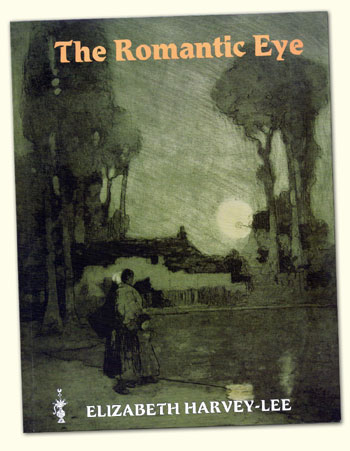
For
further information about The
Romantic Eye, please view the dedicated
page within the Catalogues section.
Printed copies of the Catalogue, published
in summer 2010, are still available,
priced
£10.
Some
of these prints - and others from the catalogue,
have since been sold.
These are marked as Sold.
Click
here to view the third selection from
this catalogue |
|
|
|
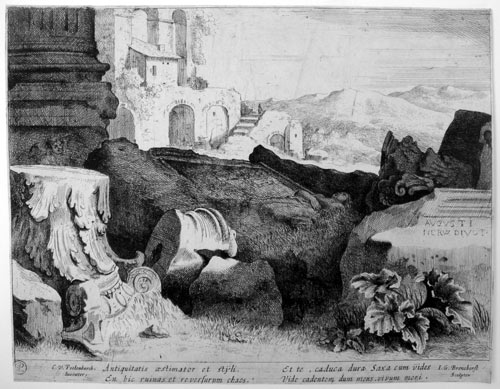 |
|
JAN
GERRITZ. VAN BRONCHORST after CORNELIS
VAN POELENBURG
Utrecht c1603 – 1661 Amsterdam
Utrecht
c1586-1667 Utrecht
Van
Poelenburg belonged to the first generation
of Dutch artists to work in Rome and paint
landscapes of the ancient remains. He returned
to Utrecht in 1626-27 and possibly at this
time taught van Bronckhorst the art of oil
painting. Both artists, perhaps coincidentally,
visited England in 1637.
Fallen remains of Ancient Roman columns
Hollstein 22 i/ii 197
x 251 mm
Etching.
The first plate, forming the title, to a
series of nine views of Roman Ruins after
Poelenburg. First state, before reduction of
the plate. A fine impression, the guide lines
for the script still clear. Trimmed to the
plate. A cockling/printing related curved crease.
Watermark: Crowned Strasburg Lily.
£2500
Ex
collection: Petersen? (Lugt 2064)
Return to top ^ |
|
|
|
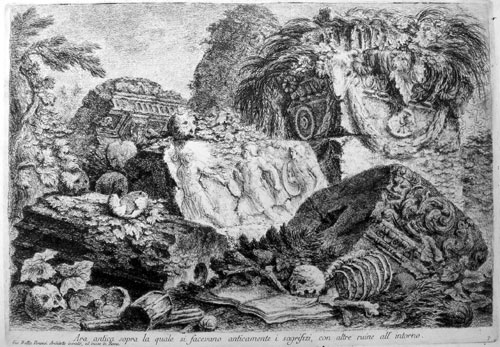 |
|
GIOVANNI BATTISTA PIRANESI
Mozzano di Mestre 1720 – 1778 Rome
Ara Antica
Robison 18 i/iv 242
x 348 mm
Original
etching, 1747. A fine early impression printed
1747-1748. On laid paper with an ornamental
letter Z watermark (Robison 47), typical of
the Venetian paper used for printing the 3rd
to 5th issues of the First Edition of Piranesi’s
Prima Parte…. A few accidental ink spots
at the very edge of the plate. One tiny pinprick
hole. A little soiled in the right margin.
An unidentified collector’s mark verso.
£1500
A new etching added as plate 7 in the third
issue (1747) of the First Edition of Prima
Parte di Architetture e Prospettive inventate
ed incise da Gio. Batta Piranesi, architetto
Veneziano.
Return to top ^ |
|
|
|
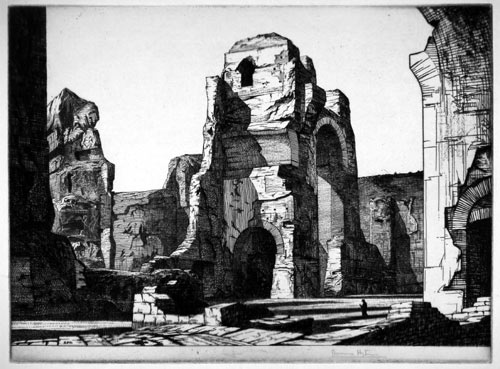 |
|
EDWARD BOUVERIE HOYTON
Lewisham 1900 – 1988 Newlyn
Bouverie
Hoyton was awarded the Prix de Rome in
1926 and was in Rome till 1929. His etchings
produced throughout this period were published
in London by the Fine Art Society.
Thermae of Caracalla
252 x 340 mm
Original
etching, 1928. The plate initialled and the
impression signed in pencil in the blank
lower plate border. Edition of 75. On cream
laid paper watermarked with a bull’s
head and star. Trace of a soft diagonal fold.
Sold
The monumental ruins of the Baths of Caracalla
in Rome.
Return
to top ^ |
|
|
|
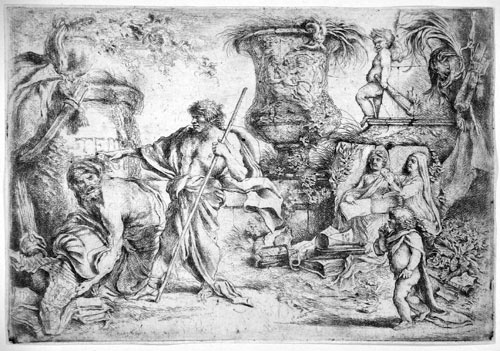 |
|
GIOVANNI BENEDETTO CASTIGLIONE
Genoa 1609 – 1664 Mantua
Castiglione’s mysterious and atmospheric etchings exploit a vein of melancholy
inspired by the remnants of ancient Rome and further enhanced by orientalist,
literary and musical allusions.
Allegory of Transience
Bartsch 27 iv/v 179
x 260 mm
Original
etching, 1655. The plate signed and dated.
Penultimate state after the inscription at
the foot removed, before the retouch. Trimmed
to thread margins. Trace of a central vertical
fold, a couple of small ink blemishes. Couple
of thin patches verso. Watermark: Circle with
Initials DML within.
Sold
Return to top ^ |
|
|
|
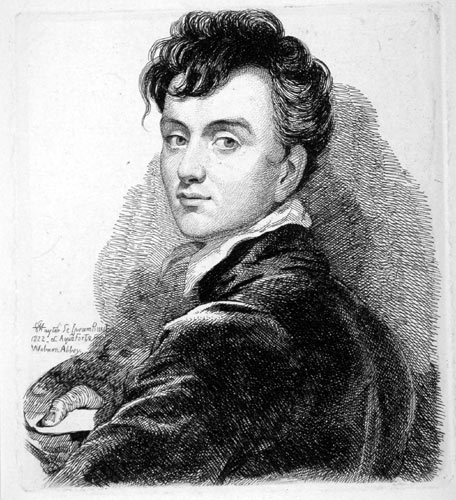 |
|
GEORGE
HAYTER
London 1792 – 1871 London
This
Byronic youthful self-portrait was etched
at Woburn Abbey. As a young artist Hayter
made etchings to entertain the patrician
households where he was invited to carry
out portrait commissions. (Hayter was later
appointed portrait and history painter to
Queen Victoria and knighted.)
Self-Portrait
135 x 122 mm
Original
etching, 1822, after a painted self-portrait.
On chine appliqué on wove. From the
only edition, issued in 1874 (most of Hayter’s
etchings were unpublished in his lifetime).
£300
Return to top ^ |
|
|
|
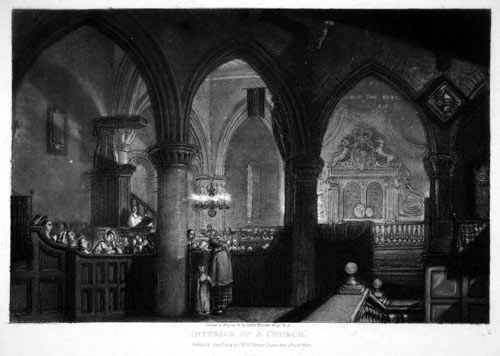 |
|
JOSEPH MALLORD WILLIAM TURNER
R.A.
London 1775 – 1851 Chelsea
Turner
conceived his Liber Studiorum in
1807 as a demonstration of his prowess in
pastoral, marine, mountainous, architectural
and historical landscape painting, and in
emulation of Claude’s Liber
Veritatis which had been published in
England in the 1770’s with plates by the mezzotint engraver Richard Earlom.
For most of his plates Turner etched the outline and employed professionals to
complete them in mezzotint. A series of hundred subjects was proposed, to be
published in Parts. The first Part was issued in 1807. Lack of success led Turner
to abandon the project twelve years on, having issued seventy-one subjects. Turner’s
relationship with his engravers was sometimes tumultuous and for later plates
occasionally he was obliged, or chose, to engrave the entire plate himself. Only
ten subjects were entirely carried out by his own hand, the Interior of a
Church was the last of these.
Interior of a Church
Finburg 70 v/v 215
x 304 mm
Original
soft-ground etching and mezzotint, 1819,
drawn, engraved and published by Turner himself,
for the final Part, Part XIV, of the Liber
Studiorum.
Final state, a rich, early impression, printed
in brown ink on laid paper without watermark.
A couple of small surface defects.
Sold
Return to top ^ |
|
|
|
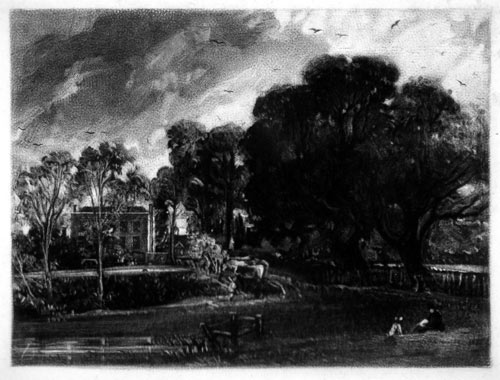 |
|
After JOHN CONSTABLE R.A.
East Bergholt 1776 – 1837 Hampstead
Having
established his reputation in the 1820’s
Constable, like Turner, decided to publish a
series of mezzotints to demonstrate his personal
vision of landscape. Comprising twenty-two subjects,
they were published in Parts periodically, 1830-32,
as the plates were completed, and collectively
in 1834 with the title English Landscape
Scenery and a letterpress commentary
by Constable. (And Bohn would re-print all
the plates posthumously in 1855.)
Constable’s fresh approach to nature, immediacy
of atmospheric effect and directness of execution
had made his paintings much admired by the French
Romantics. He was the star of the Paris Salon
in 1824.
Mezzotint lent itself to vivid translation
of the painterly effects in Constable’s oil
sketches specially produced for the series to
show the “chiaroscuro of Nature”,
the natural drama of changing light effects.
Constable worked in close collaboration with
his chosen engraver, David Lucas (1892 – 1881),
through a series of progress proofs and touched
proofs for each plate until he was entirely satisfied
with the result.
The
Artist’s Home at
East Bergholt, Evening
Shirley 27, progress proof 139
x 186 (image); 232 239 mm (plate)
Mezzotint,
1831, engraved by David Lucas. A progress
proof, before considerable lightening in
the foreground and the sky. Before all letters.
A fine impression on laid paper with wide margins.
A short printing crease in the blank lower
plate border, pale foxing.
Sold
“This
spot saw the day spring of my life, Hours
of Joy, and years of Happiness. This place
first tinged my boyish fancy with a love
of art. This place was the origin of my fame.”
The
house built by Constable’s
father two years before John Constable was
born, with an artist sketching in the foreground.
The plate was designed as the frontispiece
to English Landscape Scenery.
Return to top
^ |
|
|
|
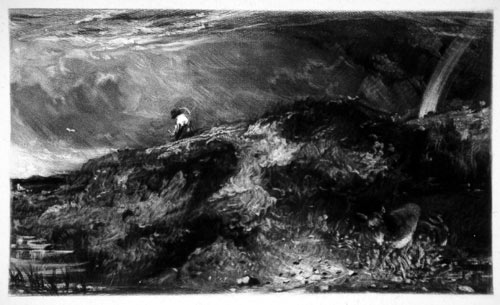 |
|
After JOHN CONSTABLE R.A.
East Bergholt 1776 – 1837 Hampstead
Vignette,
Hampstead Heath. Labourer returning
Shirley 1 progress proof e/f 91
x 154 mm (image); 166 x 229 mm (plate)
Mezzotint,
1829, by David Lucas. Penultimate progress
proof, before the silhouette of the dome
of St. Pauls and the two poplars on the distant
horizon at the left. Before all letters.
A brilliant impression on laid paper with
large margins. Minor handling and paper defects
in the wide plate borders.
Sold
According
to Lucas the figure was the artist William
Collins “who happened to be
sketching on the heath at the time” and
later acquired a pickaxe becoming the ‘labourer
returning’ of the title. A pencil drawing
of 1820 shows a similar pose.
Return to top
^ |
| |
|
Click
here to view the third selection from this
catalogue |
|
|
|
|
|
|
|